Analysis of the Murray Darling Basin: Policy, Impacts, and Solutions
VerifiedAdded on 2022/08/29
|6
|1775
|17
Essay
AI Summary
This essay examines the Murray Darling Basin in Australia, focusing on its significance for agriculture, the economy, and the environment, as well as the impact on indigenous people. The essay explores the failures of the water management policies, highlighting issues such as water theft, poor allocation, and the effects of climate change and drought. It discusses the negative impacts on the ecosystem, water prices, and the agricultural industry. The essay provides an overview of potential solutions, including water buybacks, salt interception schemes, and improved water allocation, while emphasizing the need for collective action from the government and the people of Australia to address these challenges and ensure the sustainability of the basin. The conclusion reiterates the critical importance of addressing these issues for the future well-being of Australia and its economy.
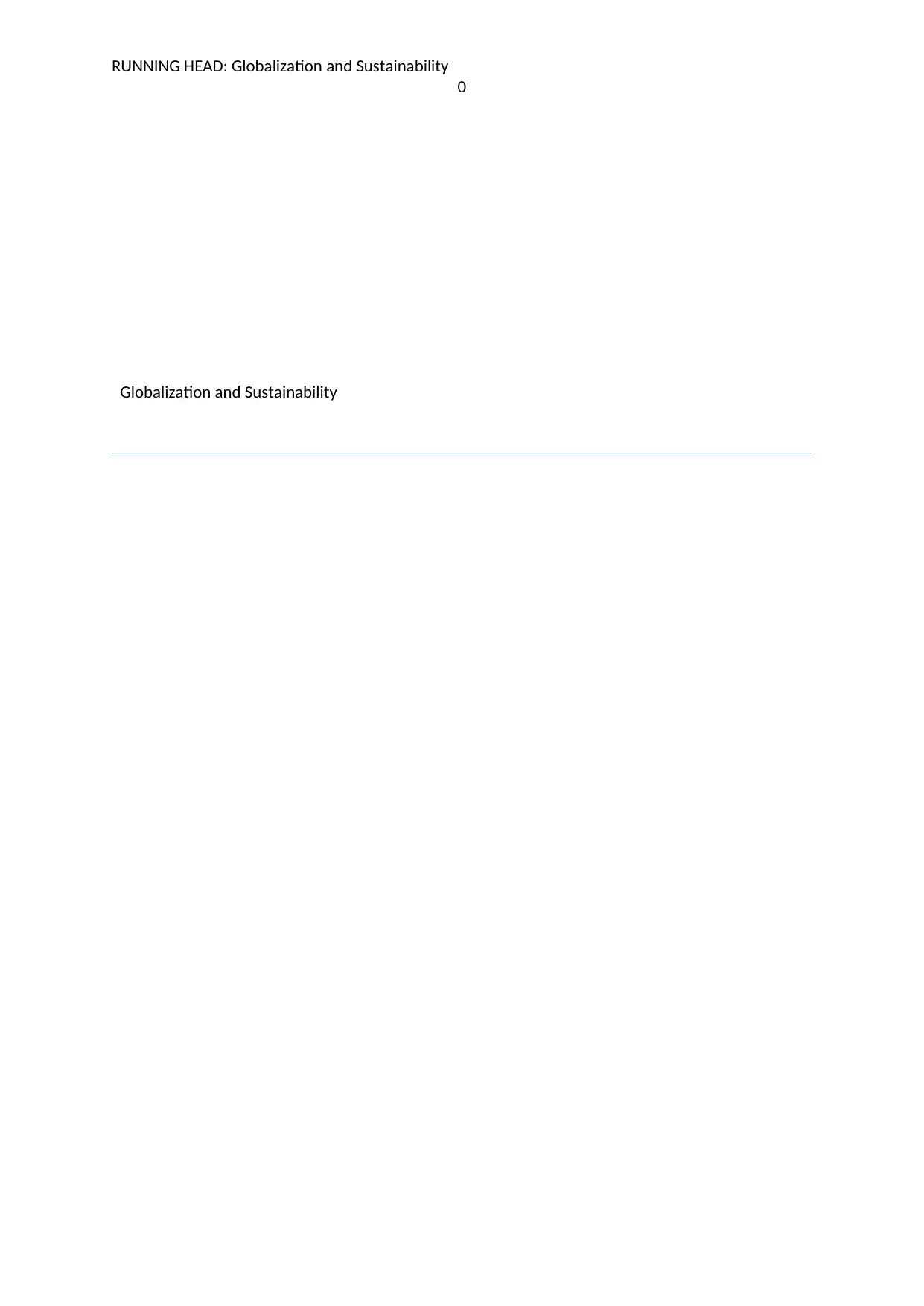
RUNNING HEAD: Globalization and Sustainability
0
Globalization and Sustainability
0
Globalization and Sustainability
Paraphrase This Document
Need a fresh take? Get an instant paraphrase of this document with our AI Paraphraser
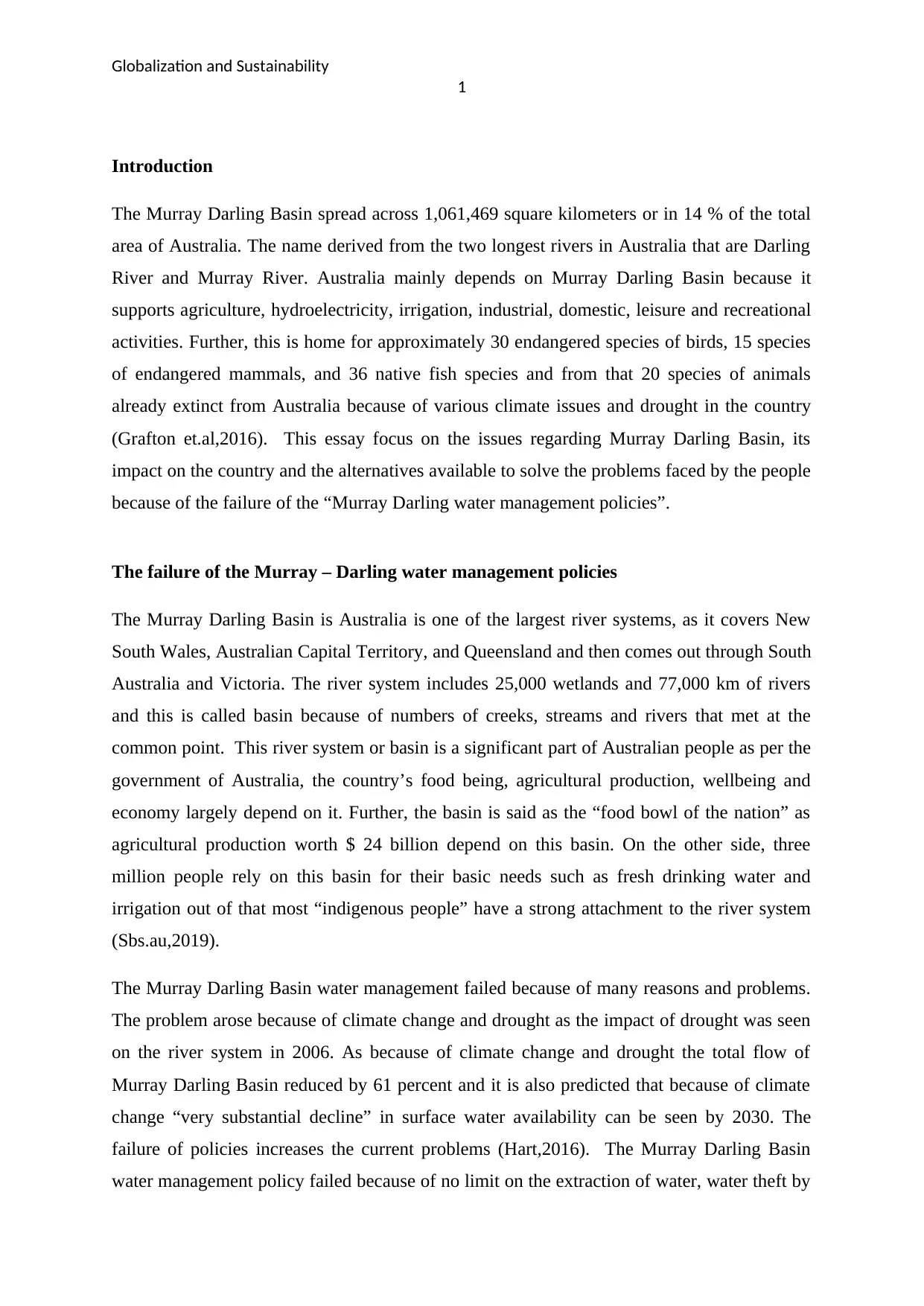
Globalization and Sustainability
1
Introduction
The Murray Darling Basin spread across 1,061,469 square kilometers or in 14 % of the total
area of Australia. The name derived from the two longest rivers in Australia that are Darling
River and Murray River. Australia mainly depends on Murray Darling Basin because it
supports agriculture, hydroelectricity, irrigation, industrial, domestic, leisure and recreational
activities. Further, this is home for approximately 30 endangered species of birds, 15 species
of endangered mammals, and 36 native fish species and from that 20 species of animals
already extinct from Australia because of various climate issues and drought in the country
(Grafton et.al,2016). This essay focus on the issues regarding Murray Darling Basin, its
impact on the country and the alternatives available to solve the problems faced by the people
because of the failure of the “Murray Darling water management policies”.
The failure of the Murray – Darling water management policies
The Murray Darling Basin is Australia is one of the largest river systems, as it covers New
South Wales, Australian Capital Territory, and Queensland and then comes out through South
Australia and Victoria. The river system includes 25,000 wetlands and 77,000 km of rivers
and this is called basin because of numbers of creeks, streams and rivers that met at the
common point. This river system or basin is a significant part of Australian people as per the
government of Australia, the country’s food being, agricultural production, wellbeing and
economy largely depend on it. Further, the basin is said as the “food bowl of the nation” as
agricultural production worth $ 24 billion depend on this basin. On the other side, three
million people rely on this basin for their basic needs such as fresh drinking water and
irrigation out of that most “indigenous people” have a strong attachment to the river system
(Sbs.au,2019).
The Murray Darling Basin water management failed because of many reasons and problems.
The problem arose because of climate change and drought as the impact of drought was seen
on the river system in 2006. As because of climate change and drought the total flow of
Murray Darling Basin reduced by 61 percent and it is also predicted that because of climate
change “very substantial decline” in surface water availability can be seen by 2030. The
failure of policies increases the current problems (Hart,2016). The Murray Darling Basin
water management policy failed because of no limit on the extraction of water, water theft by
1
Introduction
The Murray Darling Basin spread across 1,061,469 square kilometers or in 14 % of the total
area of Australia. The name derived from the two longest rivers in Australia that are Darling
River and Murray River. Australia mainly depends on Murray Darling Basin because it
supports agriculture, hydroelectricity, irrigation, industrial, domestic, leisure and recreational
activities. Further, this is home for approximately 30 endangered species of birds, 15 species
of endangered mammals, and 36 native fish species and from that 20 species of animals
already extinct from Australia because of various climate issues and drought in the country
(Grafton et.al,2016). This essay focus on the issues regarding Murray Darling Basin, its
impact on the country and the alternatives available to solve the problems faced by the people
because of the failure of the “Murray Darling water management policies”.
The failure of the Murray – Darling water management policies
The Murray Darling Basin is Australia is one of the largest river systems, as it covers New
South Wales, Australian Capital Territory, and Queensland and then comes out through South
Australia and Victoria. The river system includes 25,000 wetlands and 77,000 km of rivers
and this is called basin because of numbers of creeks, streams and rivers that met at the
common point. This river system or basin is a significant part of Australian people as per the
government of Australia, the country’s food being, agricultural production, wellbeing and
economy largely depend on it. Further, the basin is said as the “food bowl of the nation” as
agricultural production worth $ 24 billion depend on this basin. On the other side, three
million people rely on this basin for their basic needs such as fresh drinking water and
irrigation out of that most “indigenous people” have a strong attachment to the river system
(Sbs.au,2019).
The Murray Darling Basin water management failed because of many reasons and problems.
The problem arose because of climate change and drought as the impact of drought was seen
on the river system in 2006. As because of climate change and drought the total flow of
Murray Darling Basin reduced by 61 percent and it is also predicted that because of climate
change “very substantial decline” in surface water availability can be seen by 2030. The
failure of policies increases the current problems (Hart,2016). The Murray Darling Basin
water management policy failed because of no limit on the extraction of water, water theft by
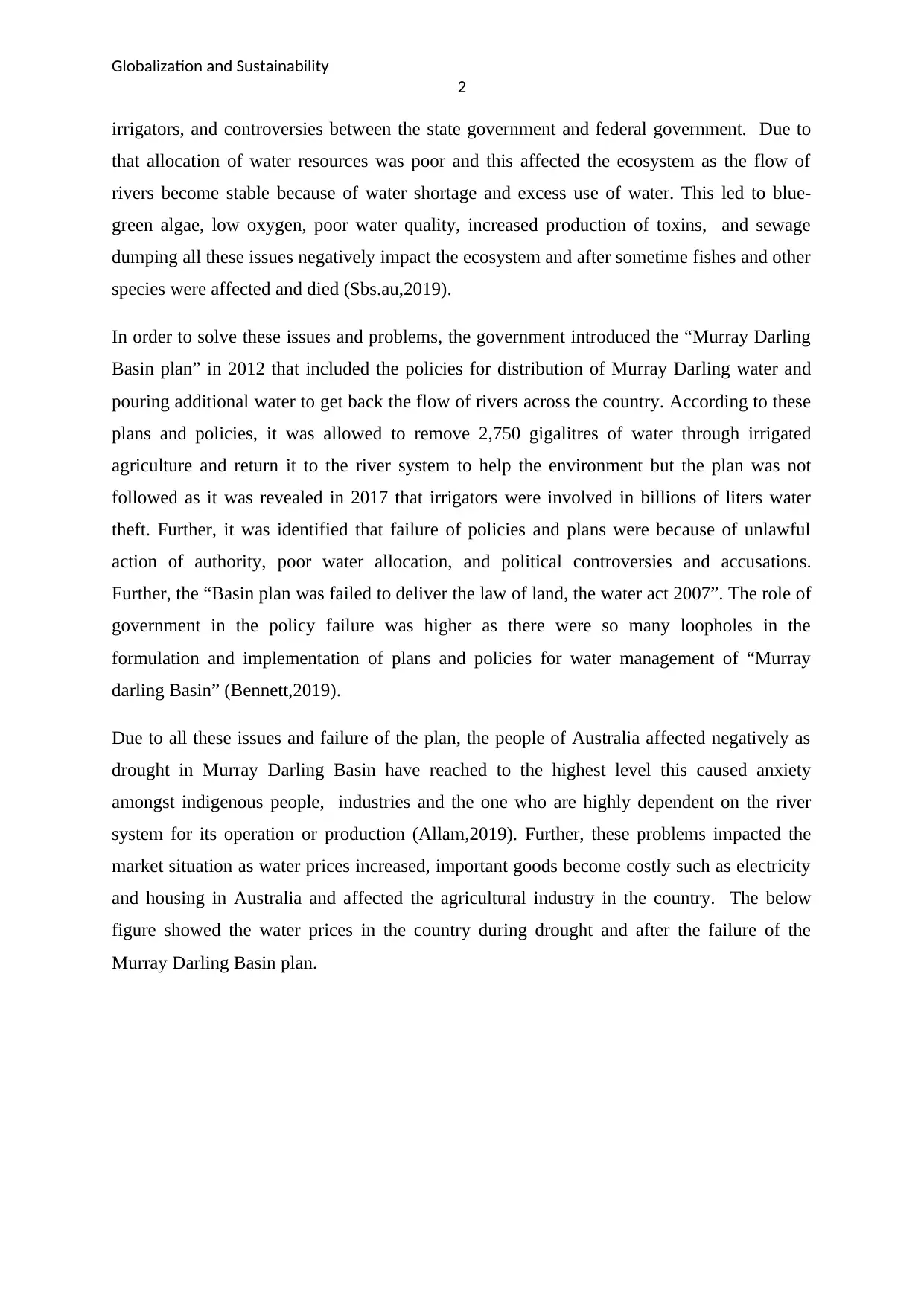
Globalization and Sustainability
2
irrigators, and controversies between the state government and federal government. Due to
that allocation of water resources was poor and this affected the ecosystem as the flow of
rivers become stable because of water shortage and excess use of water. This led to blue-
green algae, low oxygen, poor water quality, increased production of toxins, and sewage
dumping all these issues negatively impact the ecosystem and after sometime fishes and other
species were affected and died (Sbs.au,2019).
In order to solve these issues and problems, the government introduced the “Murray Darling
Basin plan” in 2012 that included the policies for distribution of Murray Darling water and
pouring additional water to get back the flow of rivers across the country. According to these
plans and policies, it was allowed to remove 2,750 gigalitres of water through irrigated
agriculture and return it to the river system to help the environment but the plan was not
followed as it was revealed in 2017 that irrigators were involved in billions of liters water
theft. Further, it was identified that failure of policies and plans were because of unlawful
action of authority, poor water allocation, and political controversies and accusations.
Further, the “Basin plan was failed to deliver the law of land, the water act 2007”. The role of
government in the policy failure was higher as there were so many loopholes in the
formulation and implementation of plans and policies for water management of “Murray
darling Basin” (Bennett,2019).
Due to all these issues and failure of the plan, the people of Australia affected negatively as
drought in Murray Darling Basin have reached to the highest level this caused anxiety
amongst indigenous people, industries and the one who are highly dependent on the river
system for its operation or production (Allam,2019). Further, these problems impacted the
market situation as water prices increased, important goods become costly such as electricity
and housing in Australia and affected the agricultural industry in the country. The below
figure showed the water prices in the country during drought and after the failure of the
Murray Darling Basin plan.
2
irrigators, and controversies between the state government and federal government. Due to
that allocation of water resources was poor and this affected the ecosystem as the flow of
rivers become stable because of water shortage and excess use of water. This led to blue-
green algae, low oxygen, poor water quality, increased production of toxins, and sewage
dumping all these issues negatively impact the ecosystem and after sometime fishes and other
species were affected and died (Sbs.au,2019).
In order to solve these issues and problems, the government introduced the “Murray Darling
Basin plan” in 2012 that included the policies for distribution of Murray Darling water and
pouring additional water to get back the flow of rivers across the country. According to these
plans and policies, it was allowed to remove 2,750 gigalitres of water through irrigated
agriculture and return it to the river system to help the environment but the plan was not
followed as it was revealed in 2017 that irrigators were involved in billions of liters water
theft. Further, it was identified that failure of policies and plans were because of unlawful
action of authority, poor water allocation, and political controversies and accusations.
Further, the “Basin plan was failed to deliver the law of land, the water act 2007”. The role of
government in the policy failure was higher as there were so many loopholes in the
formulation and implementation of plans and policies for water management of “Murray
darling Basin” (Bennett,2019).
Due to all these issues and failure of the plan, the people of Australia affected negatively as
drought in Murray Darling Basin have reached to the highest level this caused anxiety
amongst indigenous people, industries and the one who are highly dependent on the river
system for its operation or production (Allam,2019). Further, these problems impacted the
market situation as water prices increased, important goods become costly such as electricity
and housing in Australia and affected the agricultural industry in the country. The below
figure showed the water prices in the country during drought and after the failure of the
Murray Darling Basin plan.
⊘ This is a preview!⊘
Do you want full access?
Subscribe today to unlock all pages.

Trusted by 1+ million students worldwide
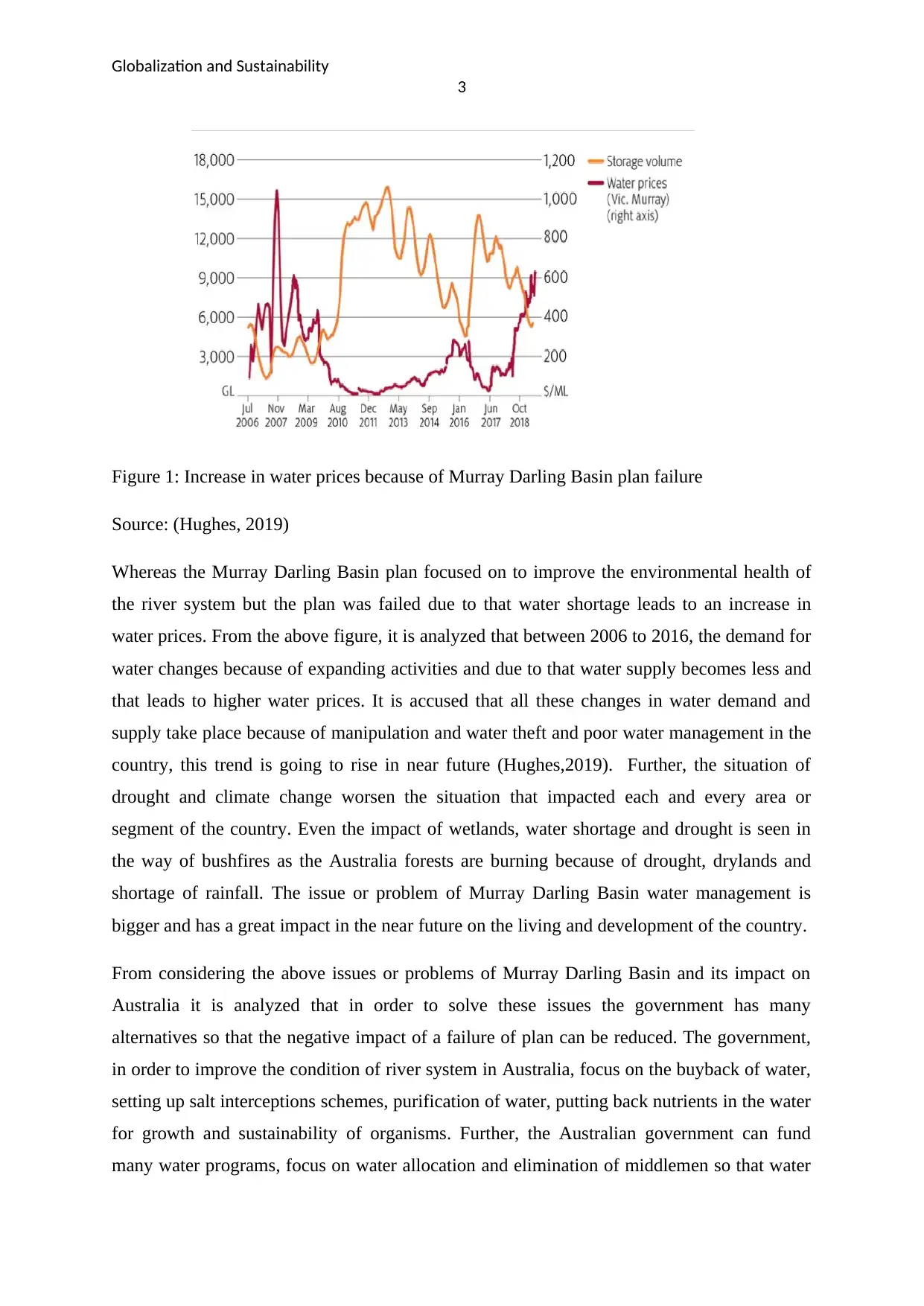
Globalization and Sustainability
3
Figure 1: Increase in water prices because of Murray Darling Basin plan failure
Source: (Hughes, 2019)
Whereas the Murray Darling Basin plan focused on to improve the environmental health of
the river system but the plan was failed due to that water shortage leads to an increase in
water prices. From the above figure, it is analyzed that between 2006 to 2016, the demand for
water changes because of expanding activities and due to that water supply becomes less and
that leads to higher water prices. It is accused that all these changes in water demand and
supply take place because of manipulation and water theft and poor water management in the
country, this trend is going to rise in near future (Hughes,2019). Further, the situation of
drought and climate change worsen the situation that impacted each and every area or
segment of the country. Even the impact of wetlands, water shortage and drought is seen in
the way of bushfires as the Australia forests are burning because of drought, drylands and
shortage of rainfall. The issue or problem of Murray Darling Basin water management is
bigger and has a great impact in the near future on the living and development of the country.
From considering the above issues or problems of Murray Darling Basin and its impact on
Australia it is analyzed that in order to solve these issues the government has many
alternatives so that the negative impact of a failure of plan can be reduced. The government,
in order to improve the condition of river system in Australia, focus on the buyback of water,
setting up salt interceptions schemes, purification of water, putting back nutrients in the water
for growth and sustainability of organisms. Further, the Australian government can fund
many water programs, focus on water allocation and elimination of middlemen so that water
3
Figure 1: Increase in water prices because of Murray Darling Basin plan failure
Source: (Hughes, 2019)
Whereas the Murray Darling Basin plan focused on to improve the environmental health of
the river system but the plan was failed due to that water shortage leads to an increase in
water prices. From the above figure, it is analyzed that between 2006 to 2016, the demand for
water changes because of expanding activities and due to that water supply becomes less and
that leads to higher water prices. It is accused that all these changes in water demand and
supply take place because of manipulation and water theft and poor water management in the
country, this trend is going to rise in near future (Hughes,2019). Further, the situation of
drought and climate change worsen the situation that impacted each and every area or
segment of the country. Even the impact of wetlands, water shortage and drought is seen in
the way of bushfires as the Australia forests are burning because of drought, drylands and
shortage of rainfall. The issue or problem of Murray Darling Basin water management is
bigger and has a great impact in the near future on the living and development of the country.
From considering the above issues or problems of Murray Darling Basin and its impact on
Australia it is analyzed that in order to solve these issues the government has many
alternatives so that the negative impact of a failure of plan can be reduced. The government,
in order to improve the condition of river system in Australia, focus on the buyback of water,
setting up salt interceptions schemes, purification of water, putting back nutrients in the water
for growth and sustainability of organisms. Further, the Australian government can fund
many water programs, focus on water allocation and elimination of middlemen so that water
Paraphrase This Document
Need a fresh take? Get an instant paraphrase of this document with our AI Paraphraser

Globalization and Sustainability
4
theft can be reduced and chances of data manipulation related to water management can be
reduced (Yazd et.al,2020). It is important for Australia to focus on these issues and to solve
these issues as soon as possible by putting aside the political controversies. As these issues
have become a serious concern as well being of Australia, resources of the country and
economy facing major impact. People of Australia should also focus on bringing awareness
about climate change and collectively take action to solve this issue and to reduce its impact
on the world. With the collective action of the government and people, the Murray Darling
Basin plan can be successful and bring positive changes so that the environment, organisms,
species, the ecosystem can be sustained for the future (McCormick,2019).
Conclusion
It is concluded from the above analysis that issues related to Murray Darling Basin are
increasing. Most of the population of Australia depends on Basin for basic necessities such as
drinking water and food production and agriculture activities. These issues were natural in 19
century as all issues had the solution but because of increasing human activities, increasing
population, continuous construction activities, increasing mining and farming turns this issue
as a bigger one. Australia will have a very tough time surviving if nothing is done about these
issues. The agriculture industry worth $ 24 billion and contributes more will struggle in the
near future can leads to a crash of the Australian economy. Further, deaths of fishes, extinct
of species, imbalance of ecosystem and shortage and poor quality of water all are the impact
of the failure of drought and climate change and with that failure of Murray Darling Basin
policy failure. In order to solve these issues, the government and people collectively can take
steps to “improve the health of the Basin and ensure that Australia will have enough water in
the future to meet the basic necessities” and to fulfill the needs of its increasing population.
4
theft can be reduced and chances of data manipulation related to water management can be
reduced (Yazd et.al,2020). It is important for Australia to focus on these issues and to solve
these issues as soon as possible by putting aside the political controversies. As these issues
have become a serious concern as well being of Australia, resources of the country and
economy facing major impact. People of Australia should also focus on bringing awareness
about climate change and collectively take action to solve this issue and to reduce its impact
on the world. With the collective action of the government and people, the Murray Darling
Basin plan can be successful and bring positive changes so that the environment, organisms,
species, the ecosystem can be sustained for the future (McCormick,2019).
Conclusion
It is concluded from the above analysis that issues related to Murray Darling Basin are
increasing. Most of the population of Australia depends on Basin for basic necessities such as
drinking water and food production and agriculture activities. These issues were natural in 19
century as all issues had the solution but because of increasing human activities, increasing
population, continuous construction activities, increasing mining and farming turns this issue
as a bigger one. Australia will have a very tough time surviving if nothing is done about these
issues. The agriculture industry worth $ 24 billion and contributes more will struggle in the
near future can leads to a crash of the Australian economy. Further, deaths of fishes, extinct
of species, imbalance of ecosystem and shortage and poor quality of water all are the impact
of the failure of drought and climate change and with that failure of Murray Darling Basin
policy failure. In order to solve these issues, the government and people collectively can take
steps to “improve the health of the Basin and ensure that Australia will have enough water in
the future to meet the basic necessities” and to fulfill the needs of its increasing population.
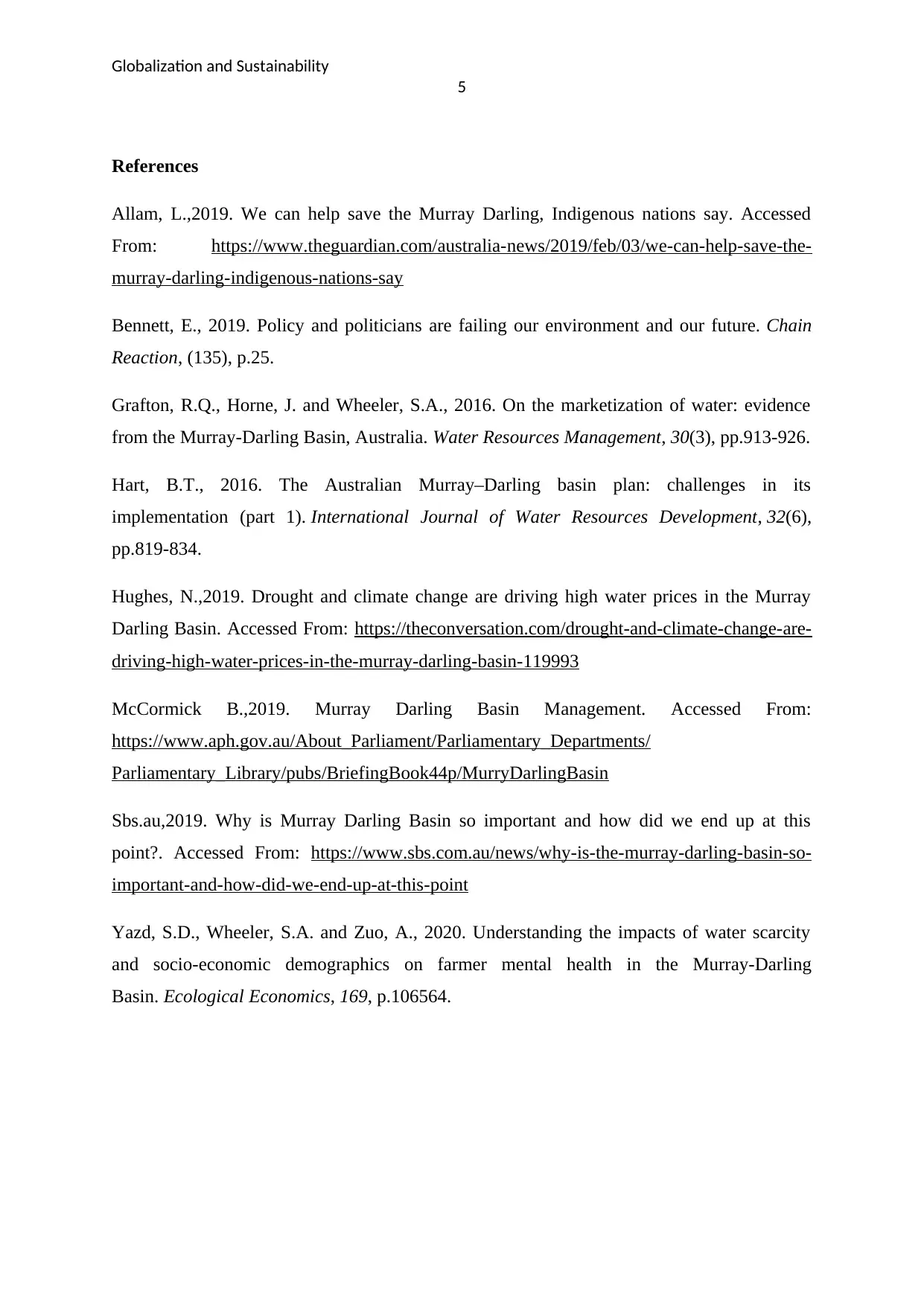
Globalization and Sustainability
5
References
Allam, L.,2019. We can help save the Murray Darling, Indigenous nations say. Accessed
From: https://www.theguardian.com/australia-news/2019/feb/03/we-can-help-save-the-
murray-darling-indigenous-nations-say
Bennett, E., 2019. Policy and politicians are failing our environment and our future. Chain
Reaction, (135), p.25.
Grafton, R.Q., Horne, J. and Wheeler, S.A., 2016. On the marketization of water: evidence
from the Murray-Darling Basin, Australia. Water Resources Management, 30(3), pp.913-926.
Hart, B.T., 2016. The Australian Murray–Darling basin plan: challenges in its
implementation (part 1). International Journal of Water Resources Development, 32(6),
pp.819-834.
Hughes, N.,2019. Drought and climate change are driving high water prices in the Murray
Darling Basin. Accessed From: https://theconversation.com/drought-and-climate-change-are-
driving-high-water-prices-in-the-murray-darling-basin-119993
McCormick B.,2019. Murray Darling Basin Management. Accessed From:
https://www.aph.gov.au/About_Parliament/Parliamentary_Departments/
Parliamentary_Library/pubs/BriefingBook44p/MurryDarlingBasin
Sbs.au,2019. Why is Murray Darling Basin so important and how did we end up at this
point?. Accessed From: https://www.sbs.com.au/news/why-is-the-murray-darling-basin-so-
important-and-how-did-we-end-up-at-this-point
Yazd, S.D., Wheeler, S.A. and Zuo, A., 2020. Understanding the impacts of water scarcity
and socio-economic demographics on farmer mental health in the Murray-Darling
Basin. Ecological Economics, 169, p.106564.
5
References
Allam, L.,2019. We can help save the Murray Darling, Indigenous nations say. Accessed
From: https://www.theguardian.com/australia-news/2019/feb/03/we-can-help-save-the-
murray-darling-indigenous-nations-say
Bennett, E., 2019. Policy and politicians are failing our environment and our future. Chain
Reaction, (135), p.25.
Grafton, R.Q., Horne, J. and Wheeler, S.A., 2016. On the marketization of water: evidence
from the Murray-Darling Basin, Australia. Water Resources Management, 30(3), pp.913-926.
Hart, B.T., 2016. The Australian Murray–Darling basin plan: challenges in its
implementation (part 1). International Journal of Water Resources Development, 32(6),
pp.819-834.
Hughes, N.,2019. Drought and climate change are driving high water prices in the Murray
Darling Basin. Accessed From: https://theconversation.com/drought-and-climate-change-are-
driving-high-water-prices-in-the-murray-darling-basin-119993
McCormick B.,2019. Murray Darling Basin Management. Accessed From:
https://www.aph.gov.au/About_Parliament/Parliamentary_Departments/
Parliamentary_Library/pubs/BriefingBook44p/MurryDarlingBasin
Sbs.au,2019. Why is Murray Darling Basin so important and how did we end up at this
point?. Accessed From: https://www.sbs.com.au/news/why-is-the-murray-darling-basin-so-
important-and-how-did-we-end-up-at-this-point
Yazd, S.D., Wheeler, S.A. and Zuo, A., 2020. Understanding the impacts of water scarcity
and socio-economic demographics on farmer mental health in the Murray-Darling
Basin. Ecological Economics, 169, p.106564.
⊘ This is a preview!⊘
Do you want full access?
Subscribe today to unlock all pages.

Trusted by 1+ million students worldwide
1 out of 6
Related Documents
Your All-in-One AI-Powered Toolkit for Academic Success.
+13062052269
info@desklib.com
Available 24*7 on WhatsApp / Email
![[object Object]](/_next/static/media/star-bottom.7253800d.svg)
Unlock your academic potential
Copyright © 2020–2025 A2Z Services. All Rights Reserved. Developed and managed by ZUCOL.




